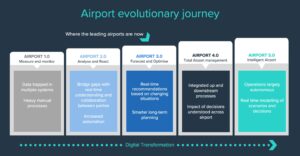Airports of all sizes are setting lofty goals to transform travel experiences and sustainably grow traffic. However, gearing up quickly to meet new demand is not easy – physical expansions have long lead times, ramping up staff experience doesn’t happen overnight and airline needs are constantly evolving. It’s clear that the current playbook – largely relying on manual tasks and reactive decision making – has had its day. Airports need a new approach to move aircraft, people and bags more efficiently and in a more predictable manner.
Total airport management (TAM) has emerged as a beacon for a smarter, automated and more resilient future. With TAM, operations and decisions are integrated and optimized across landside and airside, with technology and data serving as the glue uniting functions and people.
Airports are trying out different game plans in their move to actualize TAM. Some trust their instinct and hope for small wins along the way, while others get tangled in super-detailed technology roadmaps that can miss the human angle, which is to keep everyone working together and build trust. The trick is forging a pragmatic path that is both clear and progressive, steering all parties toward the seamless unity TAM is all about.
Introducing the Airport Evolutionary Model
The Airport Evolutionary Model is the way we define where an airport is on the transition to total airport management – to help them understand and plan for the next step in their journey toward more automated, better-performing operations.
From working with airports of all sizes across the world, we see five distinct maturity levels in that transition. Interestingly, where airports are on that journey can differ widely between teams, locations and across their aviation partners.
Airport 1.0: Measures and monitors in real time
If you are an airport in this stage, you tend to experience issues with data trapped across multiple siloed systems which can lead to misaligned and conflicting views. Your planners tend to work from schedule data, meaning that long lag times exist between seeing an issue and responding to it.
While you may not yet have the technology in place, you are most likely considering how you can understand what’s going on across your operations right now. How are passengers flowing through each area – is congestion building at any single point? What’s happening with flights – are they on schedule? What about passengers’ bags – are there any delays at the carousels?
The key here is to tap into real-world data to get the most accurate view of the situation at hand so you can act quickly when issues arise.
Airport 2.0: Shares, acts and analyzes
At the next level, airports are getting that real-time view out of stovepipes to ensure all stakeholders have a common understanding of what’s happening to support better cooperation and planning.
For example, airports typically introduce airport collaborative decision making at Level 2.0 – sharing key real-time milestones in the aircraft turnaround with their aviation partners so everyone is working with the same, live information.
However, the real difference at this level is not just monitoring but being able to analyze and measure the impact of operational changes. For example, terminal operators may want to increase the amount of peak time passengers spend in airside retail. This could come from improved parking flow, shorter queues at security or adjusting the call-to-gate. However, each has a ‘cost’. What’s key is knowing which decision offers the best trade-off by analyzing data.
Several years ago, Schiphol airport decided to extend its people flow insight, moving from single-process measurement to analyzing how people from each flight move and dwell throughout the airport. With this granular curb-to-gate insight, they know that every time they make a change to a security plan, they can assess the impact on not only queues but also movement and occupancy in departure lounges and gates.
Airport 3.0: Forecasts and optimizes
At this level, airports begin to move beyond tactical, reactive decision making and toward proactive operations that consider upstream and downstream events. To support this, the boundary between planning and day of operations is becoming continuous and seamless.
Machine learning (ML) and scenario planning play a key role at Airport 3.0, helping to craft better plans and augment decision making based on the changing situation and current constraints. For example, this could be determining the best immigration lane opening plan to maximize throughput based on current constraints and predicted arrivals, or the optimal gate allocation plan for the hours ahead.
Take Norway’s airport operator Avinor, which is using ML to predict when passengers and their bags will arrive at every point across its airports. This predictive insight not only helps Avinor make better plans but because it uses real-world data to adjust those predictions as the day unfolds, the operator and its partners can also get ahead of any potential issues before they occur.
Airport 4.0: Total Airport Management
This is where leading airports have their aims squarely pegged: looking beyond single processes to pull it all together – flight, people and baggage flows, prediction and simulation and decision support to optimize the whole airport. Here, the impact of each decision on the overall airport performance is clearly understood, and the best actions are recommended. It’s where plans and real-time decisions can be made to proactively balance resources, passengers and performance while aligning with wider airport priorities of the day.
For example, gate planners can simulate gate assignments and evaluate their impact on not only capacity but also on operational costs, the passenger experience or emissions – making the best decision that aligns with the airport’s priorities at that time.
Airport 5.0 Intelligent Automation
At the pinnacle of the evolutionary journey, delays are a thing of the past, and seamless journeys are orchestrated by intelligent systems. Automation is the norm with only a light human touch. The entire airport is dynamically optimized using real-time data, with self-adapting technologies making large system changes infrequent.
Here, systems automatically detect and adapt to changes in the wider ecosystem and previously unseen scenarios. For instance, the introduction of new aircraft types into the schedule is automated, informing gate planning tools directly. Automation will extend to the resequencing of ground handling equipment and airside buses, all operating autonomously in line with the evolving plan.
Autonomous operations, with human oversight, is the ultimate step, but it will need to be matched with robust guardrails and collaboration frameworks. Effective governance of AI and emerging technologies, developed collaboratively by airports, airlines, regulators and other aviation partners, will be essential to ensure the full potential of Airport 5.0 can be realized.

How to get started
Think of the Airport Evolutionary Journey as a common total airport management language for all stakeholders – airport authorities, airlines, ground handlers and government agencies – uniting them under a shared vision.
The key is to set your TAM ambitions upfront, break down this ambition to key business functions and start one key use case at a time – always with the big picture in mind.
In this journey, the human element – people and processes – is critical in advancing toward intelligent autonomous operations. However, the success of this transition is equally dependent on a robust technology strategy that underpins TAM ambitions.
That doesn’t mean rolling out big-bang software implementations, breathing a sigh of relief and moving on. Instead, it’s about embracing a continuous improvement mindset – to be better at getting better, knowing the big picture you want to achieve and making phased technology improvements that focus on the areas that matter first.
Harnessing the data you have and putting it to work using AI, ML and augmented decision making is the key to meeting the challenges of the new aviation model at every turn for more efficient, lean and agile operations. It’s why long-term partnerships with technology specialists are becoming more crucial to support continuous improvement and long-term planning, with ideas fed and co-created by the partners together.
Read more of the latest key opinion content from the passenger terminal industry, here.

